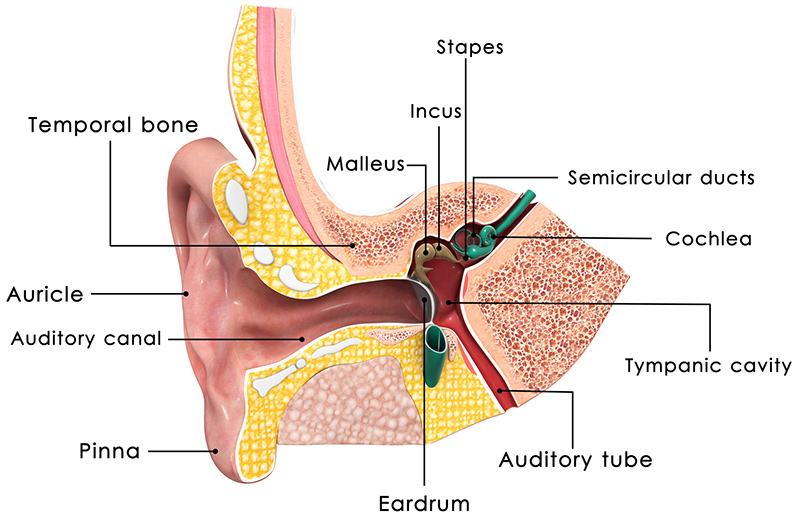
Hearing loss is the sudden or gradual decrease in hearing. Hearing loss can be mild or severe, reversible, temporary or permanent, and may affect one or both ears. The most common cause of hearing loss is age, affecting up to 25 percent of people between the ages of 65 and 75, and up to 50 percent of those over the age of 75. Age-related hearing loss, known as presbycusis, results from changes in the ear which cause gradual hearing loss. Some individuals are hearing-impaired or deaf as a result of a congenital problem or because of an illness, such as Ménière’s disease.
Causes Of Hearing Loss
Hearing loss is caused by a variety of different etiologies including genetics, noise exposure, age, middle ear fluid, wax impaction, damage to ear bones (otosclerosis, ossicular discontinuity), inner ear diseases such as Meniere’s disease and ototoxic medications.
Chronic exposure to loud noises, such as loud music or machinery
- Wax buildup in one or both ears
- Family history
- Fluid buildup due to ear infection
- Foreign object stuck in the ear canal
- Ototoxic medication
Hearing loss may be caused by perforation of the eardrum from illness or injury or damage to the tiny bones, or ossicles, of the ear.
Types Of Hearing Loss
There are three basic types of hearing loss, varying both in causes and treatment.
Conductive
In conductive hearing loss, the problem results from a structural or blockage problem with the outer or middle ear. This variety of hearing loss, which causes sounds to be less audible, is most often treated with surgery, hearing aids or bone conduction hearing technology.
Sensorineural
In sensorineural hearing loss, the difficulty results from damage to the inner ear or to the auditory nerve, most commonly because the nerve endings, also known as hair cells, are not functioning properly. Sensorineural hearing loss, which causes sounds to be less intelligible, is often treated successfully with hearing aids. For more severe-profound hearing loss a cochlear implant may be a viable treatment option.
Mixed Hearing Loss
Mixed hearing loss occurs when the patient suffers from hearing loss as a result of both neural and conductive malfunctions affecting both the both the outer or middle and the inner ear. Mixed hearing loss is most often treated with combination of treatment options including surgery, hearing aids, and bone anchored hearing aids.
Hearing loss may affect a person’s relationships, employment, education, and general quality of life. People with significant hearing loss may also suffer from feelings of isolation, depression and anxiety.
Symptoms Of Hearing Loss
While hearing loss may affect social interaction and other aspects of daily life, people are often unaware that they have a loss of hearing until others point it out to them. Common signs and symptoms of hearing loss may include:
- Complaints of muffled speech
- Inability to understand or decipher conversation
- Sensation that one or both ears are plugged
- Tinnitus, or ringing in the ears
- The individual with hearing loss speaks loudly
People who are suffering from hearing loss may constantly have a need for increased volume on radio or television.
Diagnosis Of Hearing Loss
Hearing is a sense which allows your brain to interpret sounds through our ears. The human ear has three main parts: the outer, middle, and inner ear. Each part plays a critical role in the hearing process. Hearing loss is diagnosed through a physical examination of the ears combined with diagnostic audiological assessment. The results of these comprehensive evaluations will provide information about the integrity of the hearing system as well as information regarding the audiometric limits of one’s hearing.
How Does Your Ear Work?
Hearing is a complex and intricate process. The ear is made up of three sections: the outer ear, the middle ear, and the inner ear. These parts work together so you can hear and process sounds. The outer ear, or pinna (the part you can see), picks up sound waves and directs them into the outer ear canal.
These sound waves travel down the ear canal, vibrating the eardrum.The vibrations of the eardrum moves three tiny bones in your middle ear. These bones form a chain and are called the malleus, incus and stapes. The movement of these bones converts this sound wave into mechanical energy, which is then directed toward the inner ear system known as the cochlea. The cochlea is lined with thousands of tiny nerve endings, or hair cells, that convert this mechanical energy into an electrical signal, which transmits to your brain, via the VIIIth Nerve. Your brain then interprets this signal. A breakdown in any point of this system, leaves the brain with an incomplete signal which can be unclear, muffled or distorted.
Treatment Of Hearing Loss
ENT Faculty Associates specializes in the treatment of hearing loss and balance disorders. There are numerous factors that may contribute to and/or cause hearing loss. Obtaining an accurate diagnosis is the first step in determining if the etiology of the loss is a temporary or permanent condition. Depending upon the cause of the hearing loss, our specialists will create a treatment plan tailored to your needs.
Our team will thoroughly explain the options best suitable for your hearing needs. This may include non-surgical and surgical interventions. Non-surgical interventions may include wax removal, hearing aids, and treatment of ear infections. Examples of surgical interventions for a temporary hearing loss, which sometimes can be reversed include repair of a torn (perforated) eardrum, reconstruction of the outer and/or middle ear, and removal of a cholesteatoma. Surgical treatments of more severe permanent hearing loss may include placement of a Cochlear Implant or Bone Anchored hearing aid. Your team of experts will determine which treatment option is best for you.

 Chronic exposure to loud noises, such as loud music or machinery
Chronic exposure to loud noises, such as loud music or machinery